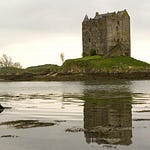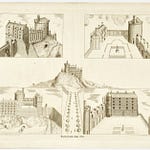Welcome back to "A Scottish Castle, A Day," brought to you by bagtownclans.com. I’m Colin MacDonald, and today, we’re exploring the fascinating history of Mearns Castle, a 15th-century tower house located in Newton Mearns, East Renfrewshire, just south of Glasgow. Mearns Castle is not only a Category A listed building, but it also stands as a unique example of how Scotland’s ancient structures have evolved over time. Today, this historic tower forms part of the Maxwell Mearns Castle Church and lends its name to the nearby Mearns Castle High School.
Built under the authority of a royal warrant issued in 1449, Mearns Castle was the brainchild of Herbert, Lord Maxwell, a powerful figure in Scotland during the reign of James II. The Maxwells were among the most influential families in the country at the time, and Mearns Castle was one of their many strongholds. Originally, the castle was designed as a defensive tower—a reflection of the turbulent times when Scotland’s feudal lords needed secure fortifications to protect themselves and their families.
Mearns Castle was with the Maxwell family for over a century until it passed into the hands of King James VI, who required the fifth Lord Maxwell to surrender it to the crown. Shortly after, it was sold to Sir George Maxwell of Nether Mearns in the mid-17th century, before eventually passing to the Shaw-Stewart family. For many years, it remained a somewhat forgotten relic of the past, its defensive walls and strategic importance fading as Scotland's political landscape changed.
However, the castle found new life in the 20th century. In 1971, the remaining storeys of the tower were incorporated into the Maxwell Mearns Castle Church, linking two modern Church of Scotland buildings. This unique blend of medieval history and modern restoration has given the old fortress a fresh purpose, allowing it to continue playing a role in the community even today.
The castle itself is a prime example of a 15th-century tower house. It was originally a four-storey rectangular structure, measuring about 30 by 40 feet, with walls a formidable 10 feet thick. This substantial thickness was necessary to withstand the sieges and attacks that were all too common in the era. The lower sections of the walls are built from rough rubble masonry, typical of early Scottish castles, while the upper walls are made from finely cut ashlar blocks, indicating that the tower might have been constructed on the foundations of an even older building.
One of the most interesting features of Mearns Castle is its now-sealed arched main entrance, which originally sat on the first storey and would have been accessed by a ladder. This entrance design was a common defensive feature of medieval tower houses, as it allowed the occupants to pull up the ladder in times of danger, making it much harder for attackers to breach the stronghold. Though walled up today, the entrance still offers a tantalizing glimpse into the architectural mindsets of the period.
Inside, the castle contains a vaulted basement room, once reached from the main entrance. The first-floor hall, also vaulted, can be accessed by a straight mural stair and features stone window seats—an indication that this space was likely used for formal gatherings or meals. In its heyday, the hall even boasted a minstrel’s gallery, where musicians could entertain the lord and his guests. This architectural detail, though no longer intact, gives us a sense of the daily life that once animated this now silent tower.
While much of the outer defenses of Mearns Castle have disappeared, faint traces remain. The rocky knoll on which the castle stands was once surrounded by a protective barmkin wall, following the natural contours of the land. A bank, roughly 10 feet high, was carved into the sloping ground to further fortify the castle’s approach, and a causeway led over this defensive bank to the tower's gatehouse. These remnants of outerworks provide crucial insights into the lengths medieval builders went to ensure their castles were not only impressive but also impenetrable.
Despite the passage of time and the many changes to its structure, Mearns Castle is one of the better-preserved medieval castles in the region. Thanks to the careful restoration work that incorporated the tower into the church, it continues to stand as a proud symbol of Scotland’s architectural and feudal past. Its story—like so many of Scotland’s ancient castles—is one of survival, adaptation, and resilience.
Whether you’re a history enthusiast, a student at the nearby Mearns Castle High School, or a local attending services at the Maxwell Mearns Castle Church, this ancient tower holds a special place in the hearts of many in East Renfrewshire. It serves as a reminder of the rich, layered history that Scotland’s castles carry with them, from their medieval origins to their modern-day uses.
Thank you for joining us on this episode of "A Scottish Castle, A Day." I hope you’ve enjoyed uncovering the story of Mearns Castle with me. Be sure to tune in tomorrow as we continue our journey through Scotland’s remarkable fortresses. Until then, I’m Colin MacDonald, and as always—Slán go fóill!













Share this post